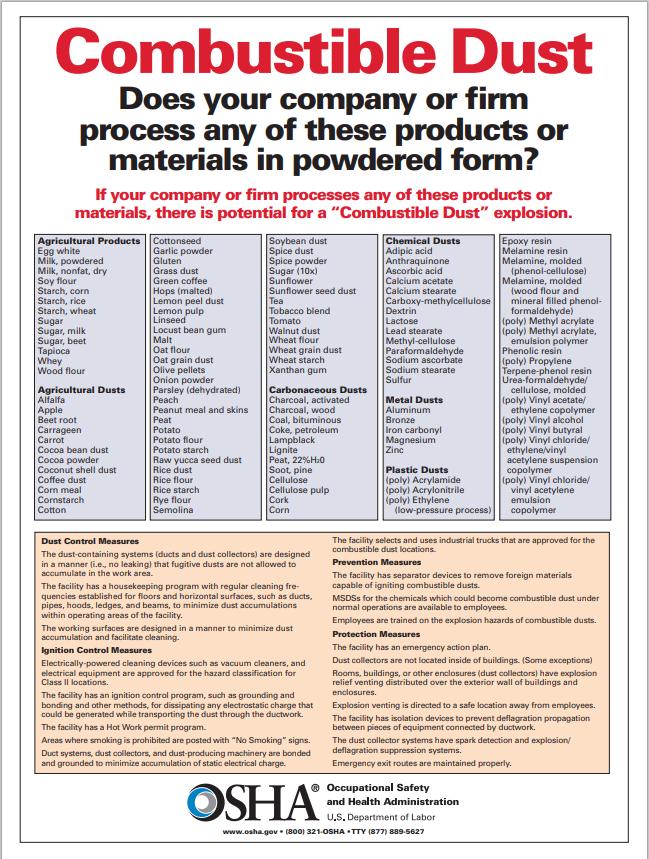Historic metal related dust explosions serve as sobering reminders of the inherent risks present in industrial settings. These metal dusts fires and combustible dusts incidents occur due to a combination of factors unique to the metal processing environment. Metal manufacturing processes such as grinding, cutting, and welding generate metal dusts that can accumulate in metal dust collection systems, in the air, and on surfaces. When these metal dust particles reach a critical concentration, and are exposed to an ignition source, such as sparks or hot surfaces, they can ignite rapidly, resulting in devastating explosions. Additionally, factors such as inadequate ventilation, improper housekeeping practices, clogged metal dust collection systems, and the presence of other combustible materials further exacerbate the risk of combustible metal dusts explosions in the metal process industry. Understanding the complex interplay of these factors is essential for developing effective loss prevention measures and safety protocols to mitigate the potential for future metals dusts generation, metal dust explosions, metal dust fires, and metal dust incidents.

Conclusion
The occurrences of combustible dust explosions within the metal industries underscore the critical importance of prioritizing safety measures and regulatory compliance to mitigate such metal fires and health risks effectively. The incidents highlighted, including those at PEPCON, the Hoeganaes Corporation, Hayes Lemmerz International, and exemplify the devastating consequences that can arise when combustible metal dusts accumulates unchecked in metal processing facilities. These tragedies resulted in loss of life, injuries, and extensive damage, serving as poignant reminders of the urgent need for robust preventive safety measures, process safety, and environmental protection.
Moreover, these incidents underscore the necessity of proactive risk assessment and implementation of comprehensive safety protocols within the metal sector. Measures such as regular equipment maintenance, effective control systems such as maintained metal dust collection systems, employee training, and adherence to a strict regulatory combustible dust standard, such as NFPA 484, are imperative to minimize the potential for metal dusts accumulation, and combustible dusts explosions. Additionally, fostering a culture of safety consciousness among workers and management is essential in promoting a collaborative approach toward identifying and addressing potential metal dusts hazards before they escalate into health risks and catastrophic events.
Moving forward, stakeholders in the metal sectors must learn from past incidents, prioritize process safety above all else, and continually strive towards enhancing loss prevention measures, with a combustible dust hazards analysis, and emergency response protocols. By doing so, a safer work environment can prevent metal dust generation, and metal dust fires and metal dust explosions, that protect both personnel and infrastructure from the inherent risks associated with combustible dust in metal processing operations. Through collective efforts and a steadfast commitment to safety, we can mitigate the occurrence of combustible dust explosions, increase loss prevention, increase environmental protection from dust hazards, and ensure the well-being of people involved in the metal industries.
About Dust Safety Science
For more from Dr. Chris Cloney on Combustible Dust in the Metal Working Industry, visit this podcast episode: Metal Dust Explosion Loss History, Severity & Practical Consideration.

Resources:
Visit Dust Safety Science (Global Incident Tracking)
Visit Dust Safety Academy (Resources, Training, and Events)
Visit Dust Safety Professionals (Need Help? Get Support Today!)
Visit Dust Safety Journal for the Complimentary, Dust Safety Science Monthly Journal
Subscribe to our Complimentary, Dust Safety Science Newsletter at Dust Safety Science Newsletter
Visit the Dust Safety Science blog for written articles on combustible dust safety including the latest research, expert opinions, and state-of-the-art in fire and explosion protection.
